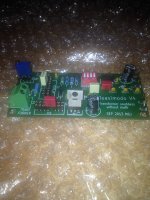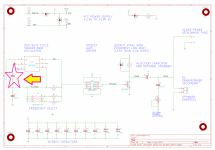On the same token, my mum always tells me to be mindful that being kind or being curt is a fine line depending on how we present it.
@Dewdrop,
My lack of sophistication in electronics leads me to use X2/Y2 rated safety capacitors in snubbers where I can, since to me they appear to be "across the line", although generally at low voltage where I use them. I think (?) member Jeff Young gently suggested this previously as well (I unabashedly stand on the shoulders of those wiser/smarter than me.)
Is an X2 rating inappropriate or too conservative? Perhaps, but in the case of an over-voltage/over-current event, I have some assurance that they will fail predictably and not start a fire because of their construction.
A disadvantage is that because of their construction, it's hard to find case sizes smaller than pcm 7.5 or 10 for the capacitance values suggested by Quasimodo. And they may be a bit more expensive than non-safety caps.
I have been using Kemet R46 and Rifa PHE840 without event.
My lack of sophistication in electronics leads me to use X2/Y2 rated safety capacitors in snubbers where I can, since to me they appear to be "across the line", although generally at low voltage where I use them. I think (?) member Jeff Young gently suggested this previously as well (I unabashedly stand on the shoulders of those wiser/smarter than me.)
Is an X2 rating inappropriate or too conservative? Perhaps, but in the case of an over-voltage/over-current event, I have some assurance that they will fail predictably and not start a fire because of their construction.
A disadvantage is that because of their construction, it's hard to find case sizes smaller than pcm 7.5 or 10 for the capacitance values suggested by Quasimodo. And they may be a bit more expensive than non-safety caps.
I have been using Kemet R46 and Rifa PHE840 without event.
Last edited:
Thanks Jim, you are always very kind to all the brands. ;-)
Because in this application there’s absolutely no difference at all. Operational and on-spec is all that matters. 😀
@Dewdrop,
My lack of sophistication in electronics leads me to use X2/Y2 rated safety capacitors in snubbers where I can, since to me they appear to be "across the line", although generally at low voltage where I use them. I think (?) member Jeff Young gently suggested this previously as well (I unabashedly stand on the shoulders of those wiser/smarter than me.)
Is an X2 rating inappropriate or too conservative? Perhaps, but in the case of an over-voltage/over-current event, I have some assurance that they will fail predictably and not start a fire because of their construction.
A disadvantage is that because of their construction, it's hard to find case sizes smaller than pcm 7.5 or 10 for the capacitance values suggested by Quasimodo. And they may be a bit more expensive than non-safety caps.
I have been using Kemet R46 and Rifa PHE840 without event.
Thanks Johnny!
Occasionally I've thought about replacing Cx in a transformer secondary snubber, with a Metal Oxide Varistor. MOVs are overvoltage protection devices, similar to big gigantic bidirectional zener diodes. Because of their large size, big MOVs have lots of capacitance between their terminals. Some datasheets say it's tens of nanofarads. Bingo, right in Cx territory.
Unfortunately, the capacitance of a MOV is nonlinear. It varies with voltage. This makes Quasimodo-style testing a bit more involved, since now you must apply the correct bias voltage to "Cx" while performing the bell-ringing experiments. It's probably possible but undoubtedly messy.
It might be true that using a surge protector outlet strip, between the audio equipment and the AC mains, is easier.
Unfortunately, the capacitance of a MOV is nonlinear. It varies with voltage. This makes Quasimodo-style testing a bit more involved, since now you must apply the correct bias voltage to "Cx" while performing the bell-ringing experiments. It's probably possible but undoubtedly messy.
It might be true that using a surge protector outlet strip, between the audio equipment and the AC mains, is easier.
It might be true that using a surge protector outlet strip, between the audio equipment and the AC mains, is easier.
I assembled a decent L C filter within a metal cased power strip. It works well, and need to make another one, but the inductor cores had been a common item at Radio Shack, so I need to hunt down a very similar one to use.
The other end of the spectrum is a G.D.T. (gas discharge tube) whose capacitance is tiny, sub-10pF, because it's just a pair of electrodes in a gas envelope. One of these could connect in parallel with snubbing Cx, and you would simply use Quasimodo in its standard configuration.
Last edited:
Hi orelli your PM is not working, you have to allowed PM.....in your private message setupHi Hicoco,
do you have a spare pcb for me?
Last edited:
Hi Hicoco,
post me at astrologo17@alice.it
Hi Hicoco,
tank you very much
How change the sound quality without and with the RCR QUASIMODO snubbers ?
Anyone posted some suggestion?
post me at astrologo17@alice.it
Hi Hicoco,
tank you very much
How change the sound quality without and with the RCR QUASIMODO snubbers ?
Anyone posted some suggestion?
Hi Orelli,
My experience with the audible effects of adding these snubbers is based on both first impressions as well as long-term listening. The music sounds more natural and "real" with instruments and voices being better defined and separated from other parts of the music. There seems to be a loss of "grainyness" to the sound that results in a quieter background and better dynamics. Overall everything just sounds more realistic and more pleasant to listen to. These changes have been consistent for me regardless of whether the snubbers were installed in preamps, power amps, or even the HV bias power supplies in my electrostatic speakers.
Quoted from member jameshiilj on post #604: "I myself find the effect is a lot 'smoother' sound with less fatigue plus added 'punch' and depth to the sound"
Post #823 describes another member's experiences and Mark himself talks about some differences in post #241.
Perhaps other Quasimodo users could chime in here and add their own observations.
Take care,
Doug
My experience with the audible effects of adding these snubbers is based on both first impressions as well as long-term listening. The music sounds more natural and "real" with instruments and voices being better defined and separated from other parts of the music. There seems to be a loss of "grainyness" to the sound that results in a quieter background and better dynamics. Overall everything just sounds more realistic and more pleasant to listen to. These changes have been consistent for me regardless of whether the snubbers were installed in preamps, power amps, or even the HV bias power supplies in my electrostatic speakers.
Quoted from member jameshiilj on post #604: "I myself find the effect is a lot 'smoother' sound with less fatigue plus added 'punch' and depth to the sound"
Post #823 describes another member's experiences and Mark himself talks about some differences in post #241.
Perhaps other Quasimodo users could chime in here and add their own observations.
Take care,
Doug
Hi,
As NTD4906 or STS12N3LLH5 is hard to find or obsolete, what's the best alternative so far? BTW, I am assuming TC4427 or NCP1407 will work on every MOSFET, right? Thanks.
Poting
As NTD4906 or STS12N3LLH5 is hard to find or obsolete, what's the best alternative so far? BTW, I am assuming TC4427 or NCP1407 will work on every MOSFET, right? Thanks.
Poting
Hi🙂
You should read bom in the first post. There are 2 substitutes listed:
IRLB8748, IRLU8726
You should read bom in the first post. There are 2 substitutes listed:
IRLB8748, IRLU8726
Hi🙂
You should read bom in the first post. There are 2 substitutes listed:
IRLB8748, IRLU8726
Thanks. I found the BOM already. I thought it was on the PDF, but it was not.
Hi Mark,
in the BOM oF V4 pcb the value of C1 is 1n ie 1000p.
It's correct? I think not.
Hmm... 1nF = 1000pF
- Home
- Amplifiers
- Power Supplies
- Simple, no-math transformer snubber using Quasimodo test-jig

